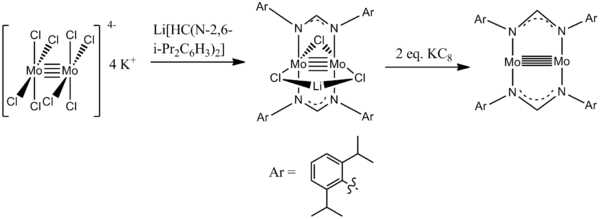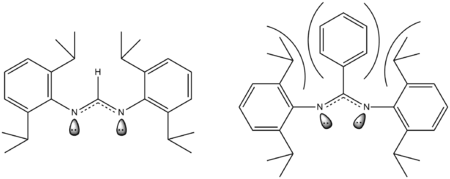Quintuple bond

A quintuple bond in chemistry is an unusual type of chemical bond, first reported in 2005 for a dichromium compound. Single bonds, double bonds, and triple bonds are commonplace in chemistry. Quadruple bonds are rarer but are currently known only among the transition metals, especially for Cr, Mo, W, and Re, e.g. [Mo2Cl8]4− and [Re2Cl8]2−. In a quintuple bond, ten electrons participate in bonding between the two metal centers, allocated as σ2π4δ4.
In some cases of high-order bonds between metal atoms, the metal-metal bonding is facilitated by ligands that link the two metal centers and reduce the interatomic distance. By contrast, the chromium dimer with quintuple bonding is stabilized by a bulky terphenyl (2,6-[(2,6-diisopropyl)phenyl]phenyl) ligands. The species is stable up to 200 °C.[1][2] The chromium–chromium quintuple bond has been analyzed with multireference ab initio and DFT methods,[3] which were also used to elucidate the role of the terphenyl ligand, in which the flanking aryls were shown to interact very weakly with the chromium atoms, causing only a small weakening of the quintuple bond.[4] A 2007 theoretical study identified two global minima for quintuple bonded RMMR compounds: a trans-bent molecular geometry and surprisingly another trans-bent geometry with the R substituent in a bridging position.[5]
In 2005, a quintuple bond was postulated to exist in the hypothetical uranium molecule U2 based on computational chemistry.[6][7] Diuranium compounds are rare, but do exist; for example, the U
2Cl2−
8 anion.
In 2007 the shortest-ever metal–metal bond (180.28 pm) was reported to exist also in a compound containing a quintuple chromium-chromium bond with diazadiene bridging ligands.[8] Other metal–metal quintuple bond containing complexes that have been reported include quintuply bonded dichromium with [6-(2,4,6-triisopropylphenyl)pyridin-2-yl](2,4,6-trimethylphenyl)amine bridging ligands[9] and a dichromium complex with amidinate bridging ligands.[10]
Synthesis of quintuple bonds is usually achieved through reduction of a dimetal species using potassium graphite. This adds valence electrons to the metal centers, giving them the needed number of electrons to participate in quintuple bonding. Below is a figure of a typical quintuple bond synthesis.
 Cr–Cr quintuple bond synthesis
Cr–Cr quintuple bond synthesis
Dimolybdenum quintuple bonds
In 2009 a dimolybdenum compound with a quintuple bond and two diamido bridging ligands was reported with a Mo–Mo bond length of 202 pm.[11] The compound was synthesised starting from potassium octachlorodimolybdate (which already contains a Mo2 quadruple bond) and a lithium amidinate, followed by reduction with potassium graphite:
 dimolybdenum quintuple bond synthesis
dimolybdenum quintuple bond synthesis
Bonding
As stated above metal-metal quintuple bonds have a σ2π4δ4 configuration. Among the five bonds present between the metal centers, one is a sigma bond, two are pi bonds, and two are delta bonds. The σ-bond is the result of mixing between the dz2 orbital on each metal center. The first π-bond comes from mixing of the dyz orbitals from each metal while the other π-bond comes from the dxz orbitals on each metal mixing. Finally the δ-bonds come from mixing of the dxy orbitals as well as mixing between the dx2−y2 orbitals from each metal.
Molecular orbital calculations have elucidated the relative energies of the orbitals created by these bonding interactions. As shown in the figure below, the lowest energy orbitals are the π bonding orbitals followed by the σ bonding orbital. The next highest are the δ bonding orbitals which represent the HOMO. Because the 10 valence electrons of the metals are used to fill these first 5 orbitals, the next highest orbital becomes the LUMO which is the δ* antibonding orbital. Though the π and δ orbitals are represented as being degenerate, they in fact are not. This is because the model shown here is a simplification and that hybridization of s, p, and d orbitals is believed to take place, causing a change in the orbital energy levels.
 MO diagram of a metal–metal quintuple bond
MO diagram of a metal–metal quintuple bond
Ligand role in metal–metal quintuple bond length
Quintuple bond lengths are heavily dependent on the ligands bound to the metal centers. Nearly all complexes containing a metal–metal quintuple bond have bidentate bridging ligands, and even those that do not, such as the terphenyl complex mentioned earlier, have some bridging characteristic to it through metal–ipso-carbon interactions.
The bidentate ligand can act as a sort of tweezer in that in order for chelation to occur the metal atoms must move closer together, thereby shortening the quintuple bond length. The two ways in which to obtain shorter metal–metal distances is to either reduce the distance between the chelating atoms in the ligand by changing the structure, or by using steric effects to force a conformational change in the ligand that bends the molecule in a way that forces the chelating atoms closer together. An example of the latter is shown below:
 Steric effects on a bidentate ligand
Steric effects on a bidentate ligand
The above example shows the ligand used in the dimolybdenum complex shown earlier. When the carbon between the two nitrogens in the ligand has a hydrogen bound to it, the steric repulsion is small. However, when the hydrogen is replaced with a much more bulky phenyl ring the steric repulsion increases dramatically and the ligand "bows" which causes a change in the orientation of the lone pairs of electrons on the nitrogen atoms. These lone pairs are what is responsible for forming bonds with the metal centers so forcing them to move closer together also forces the metal centers to be positioned closer together. Thus, decreasing the length of the quintuple bond. In the case where this ligand is bound to quintuply bonded dimolybdenum the quintuple bond length goes from 201.87 pm to 201.57 pm when the hydrogen in replaced with a phenyl group. Similar results have also been demonstrated in dichromium quintuple bond complexes as well.[12]
Future prospects
Research into quintuple bonds is still in its infancy and as a result is more of an interesting phenomenon that has no practical applications yet. These quintuple bond-containing organometallic compounds do not seem to lend themselves for use as catalysts due to their high reactivity. Current research is centered mostly on making shorter quintuple bonds, though new reactions have been reported[13][14] that have led to rarely seen metal–ligand interactions. This suggests metal–metal quintuply bonded complexes could be used as precursors to make previously unattainable compounds.
References
- ↑ Ritter, Steve (26 September 2005). "Quintuple Bond Makes Its Debut: First stable molecule with fivefold metal–metal bonding is synthesized". Chemical & Engineering News. 83 (39).
- ↑ Nguyen, Tailuan; Sutton, Andrew D.; Brynda, Marcin; Fettinger, James C.; Long, Gary J.; Power, Philip P. (2005). "Synthesis of a Stable Compound with Fivefold Bonding Between Two Chromium(I) Centers". Science. 310: 844–847. doi:10.1126/science.1116789.
- ↑ Brynda, Marcin; Gagliardi, Laura; Widmark, Per-Olof; Power, Philip P.; Roos, Björn O. (2006). "Quantum Chemical Study of the Quintuple Bond between Two Chromium Centers in [PhCrCrPh]: trans-Bent versus Linear Geometry". Angew. Chem. Int. Ed. 45 (23): 3804–3807. doi:10.1002/anie.200600110.

- ↑ La Macchia, Giovanni; Gagliardi, Laura; Power, Philip P.; Brynda, Marcin (2008). "Large Differences in Secondary Metal−Arene Interactions in the Transition-Metal Dimers ArMMAr (Ar = Terphenyl; M = Cr, Fe, or Co): Implications for Cr−Cr Quintuple Bonding". J. Am. Chem. Soc. 130 (15): 5104–5114. doi:10.1021/ja0771890.
- ↑ Merino, Gabriel; Donald, Kelling J.; D'Acchioli, Jason S.; Hoffmann, Roald (2007). "The Many Ways To Have a Quintuple Bond". J. Am. Chem. Soc. 129 (49): 15295–15302. doi:10.1021/ja075454b.
- ↑ Gagliardi, Laura; Roos, Björn O. (24 February 2005). "Quantum chemical calculations show that the uranium molecule U2 has a quintuple bond". Nature. 433: 848–851. doi:10.1038/nature03249.
- ↑ Dumé, Belle (23 February 2005). "New look for chemical bonds". PhysicsWeb.
- ↑ Kreisel, Kevin A.; Yap, Glenn P. A.; Dmitrenko, Olga; Landis, Clark R.; Theopold, Klaus H. (2007). "The Shortest Metal–Metal Bond Yet: Molecular and Electronic Structure of a Dinuclear Chromium Diazadiene Complex". J. Am. Chem. Soc. (Communication). 129 (46): 14162–14163. doi:10.1021/ja076356t.
- ↑ Noor, Awal; Wagner, Frank R.; Kempe, Rhett (2008). "Metal–Metal Distances at the Limit: A Coordination Compound with an Ultrashort Chromium–Chromium Bond". Angew. Chem. Int. Ed. 47 (38): 7246–7249. doi:10.1002/anie.200801160.
- ↑ Tsai, Yi-Chou; Hsu, Chia-Wei; Yu, Jen-Shiang K.; Lee, Gene-Hsiang; Wang, Yu; Kuo, Ting-Shen (2008). "Remarkably Short Metal–Metal Bonds: A Lantern-Type Quintuply Bonded Dichromium(I) Complex". Agnew. Chem. Int. Ed. 47 (38): 7250–7253. doi:10.1002/anie.200801286.
- ↑ Tsai, Yi-Chou; Chen, Hong-Zhang; Chang, Chie-Chieh; Yu, Jen-Shiang K.; Lee, Gene-Hsiang; Wang, Yu; Kuo, Ting-Shen (2009). "Journey from Mo–Mo Quadruple Bonds to Quintuple Bonds". J. Am. Chem. Soc. 131: 12534–12535. doi:10.1021/ja905035f.
- ↑ Hsu, Chai-Wei; Yu, Jen-Shiang K.; Yen, Chun-Hsu; Lee, Gene-Hsiang; Wang, Yu; Tsa, Yi-Chou (2008). "Quintuply-Bonded Dichromium(I) Complexes Featuring Metal–Metal Bond Lengths of 1.74 Å". Angew. Chem. Int. Ed. 47 (51): 9933–9936. doi:10.1002/anie.200803859.
- ↑ Noor, Awal; Glatz, Germund; Muller, Robert; Kaupp, Martin; Demeshko, Serhiy; Kempe, Rhett (2009). "Carboalumination of a chromium–chromium quintuple bond". Nature Chem. 1: 322–325. doi:10.1038/NCHEM.255.
- ↑ Ni, Chengbao; Ellis, Bobby D.; Long, Gary J.; Power, Philip P. (2009). "Reactions of Ar′CrCrAr′ with N2O or N3(1-Ad): complete cleavage of the Cr–Cr quintuple bond interaction". Chem. Comm. 2009: 2332–2334. doi:10.1039/b901494b.
See also
| Wikinews has related news: Delaware scientists create shortest ever metal to metal bond |